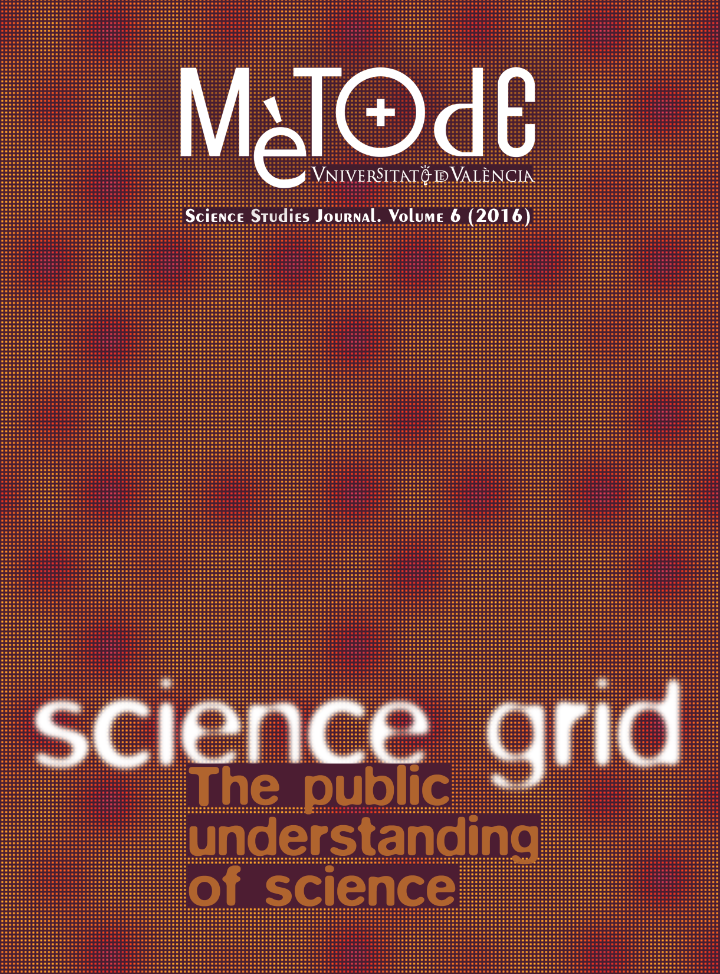The future of health communication: Innovating through partnerships
DOI:
https://doi.org/10.7203/metode.6.7096Keywords:
Health communication, health literacy, Ebola, vaccines, innovation Abstract
Abstract
The Preamble of the Constitution of the World Health Organization reminds us that «Informed opinion and active cooperation on the part of the public are of the utmost importance in the improvement of the health of the people» (Grad, 2002). Nonetheless, nearly seven decades later, the conditions under which people can be informed and actively participate in their health management in a meaningful way are being globally challenged. Drawing from experience in a variety of areas that I will delve into in this article, I remain a believer that we can marshal the necessary forces to advance the communication of health issues and create a base for a health-literate population to make smart(er), healthier decisions that advance health and well-being.
 Downloads
Downloads
 References
References
Columbia University Mailman School of Public Health. (n. d.). Public health oath. Retrieved from https://www.mailman.columbia.edu/about/mission-history/public-health-oath
Fenimore Cooper, J. (2000). The American democrat and other political writings. Washington: Regnery Publishing.
Gawande, A. (2010). The checklist manifesto: How to get things right. New York: Metropolitan Books.
Goldberg, A., Ratzan, S. C., Jacobson, K. L., & Parker, R. M. (2015). Adressing Ebola and other outbreaks: A communication checklist for global health leaders, policemakers, and practitioners. Journal of Health Communication, 20, 121–122. doi: 10.1080/10810730.2015.1007762
Grad, F. P. (2002). The preamble of the Constitution of the World Health Organization. Bulletin of the World Health Organization, 80, 981–984.
Gurman, T. A. (2015). Back to basics: Improving the conceptualization and operationalization of programmatic exposure in social and behavior change communication through conceptual models. Journal of Health Communication, 20(1), 1–3. doi: 10.1080/10810730.2015.1001699
Larson, H. J., Cooper. L. Z., Eskola, J., Katz, S. L., & Ratzan, S. C. (2011). Addressing the vaccine confidence gap. The Lancet, 378(9790), 526–535. doi: 10.1016/S0140-6736(11)60678-8
London School of Hygiene & Tropical Medicine. (2015, 23 November). Independent panel of global experts calls for critical reforms to prevent future pandemics. Retrieved from http://www.lshtm.ac.uk/newsevents/news/2015/ebola_report.html
Moon, S., Sridhar, D., Pate, M. A., Jha, A. K., Cinton, Ch., Delaunay, S., … Piot, P. (2015). Will Ebola change the game? Ten essential reforms before the next pandemic. The report of the Harvard-LSHTM independent panel on the global response to Ebola. The Lancet, 386, 2204–2221. doi: 10.1016/S0140-6736(15)00946-0
Pleasant, A. (2014). Advancing health literacy measurement: A pathway to better health and health system performance. Journal of Health Communication, 19(12), 1481–1496. doi: 10.1080/10810730.2014.954083
Pronovost, P., Needham, D., Berenholtz, S., Sinopoli, D., Chu, H., Cosgrove, S., ... Goeschel, C. (2006). An intervention to decrease catheter-related bloodstream infections in the ICU. New England Journal of Medicine, 355(26), 2725–2732. doi: 10.1056/NEJMoa061115
Ratzan, S. C. (1998). Mad cow crisis: Health and the public good. London: UCL Press.
Ratzan, S., & Parker, R. M. (2000). Introduction. In C. R. Selden, M. Zorn, S. Ratzan, & R. M. Parker (Eds.), National library of medicine current bibliographies in medicine: Health literacy. Bethesda, MD: National Institutes of Health, U.S. Department of Health and Human Services.
Ratzan, S. C., & Moritsugu, K. P. (2014). Ebola crisis – communication chaos we can avoid. Journal of Health Communication, 19(11), 1213–1215. doi: 10.1080/10810730.2014.977680
Spector, J. M., & Ratzan, S. C. (Eds.). (2012). Checklists for the last kilometer: Innovative strategies to ensure that life-saving commodities and information reach women and newborns at the moment of care. Report for Innovation Working Group. Retrieved from http://www.everywomaneverychild.org/images/Report1Checklists.pdf
The Lancet. (2012). Technologies for global health. The Lancet, 380(9840), 447. doi: 10.1016/S0140-6736(12)61273-2
United Nations. (n.d.). Goal 17: Revitalize the global partnership for sustainable development. Retrieved from http://www.un.org/sustainabledevelopment/globalpartnerships
United Nations. (2011). Political declaration of the high-level meeting of the General Assembly on the prevention and control of non-communicable diseases. Retrieved from http://www.un.org/ga/search/view_doc.asp?symbol=A/66/L.1
United Nations. (2015). Transforming our world: The 2030 agenda for sustainable development. Retrieved from https://sustainabledevelopment.un.org/post2015/transformingourworld
United Nations Population Fund. (2012). UN commission on life-saving commodities for women and children. Commisioner’s report. Retrieved from http://www.unfpa.org/sites/default/files/pub-pdf/Final%20UN%20Commission%20Report_14sept2012.pdf
World Health Organization. (2010). Every women, every child: Investing in our common future. Innovation Working Group Report. Retrieved from http://www.who.int/pmnch/activities/jointactionplan/100922_2_investing.pdf
World Health Organization. (2013). Global status report on road safety 2013. Retrieved from http://www.who.int/violence_injury_prevention/road_safety_status/2013/en
Downloads
Published
How to Cite
-
Abstract1481
-
PDF1044
Issue
Section
License
![]()
All the documents in the OJS platform are open access and property of their respective authors.
Authors publishing in the journal agree to the following terms:
- Authors keep the rights and guarantee Metode Science Studies Journal the right to be the first publication of the document, licensed under a Creative Commons Attribution-NonCommercial-NoDerivatives 4.0 International License that allows others to share the work with an acknowledgement of authorship and publication in the journal.
- Authors are allowed and encouraged to spread their work through electronic means using personal or institutional websites (institutional open archives, personal websites or professional and academic networks profiles) once the text has been published.





